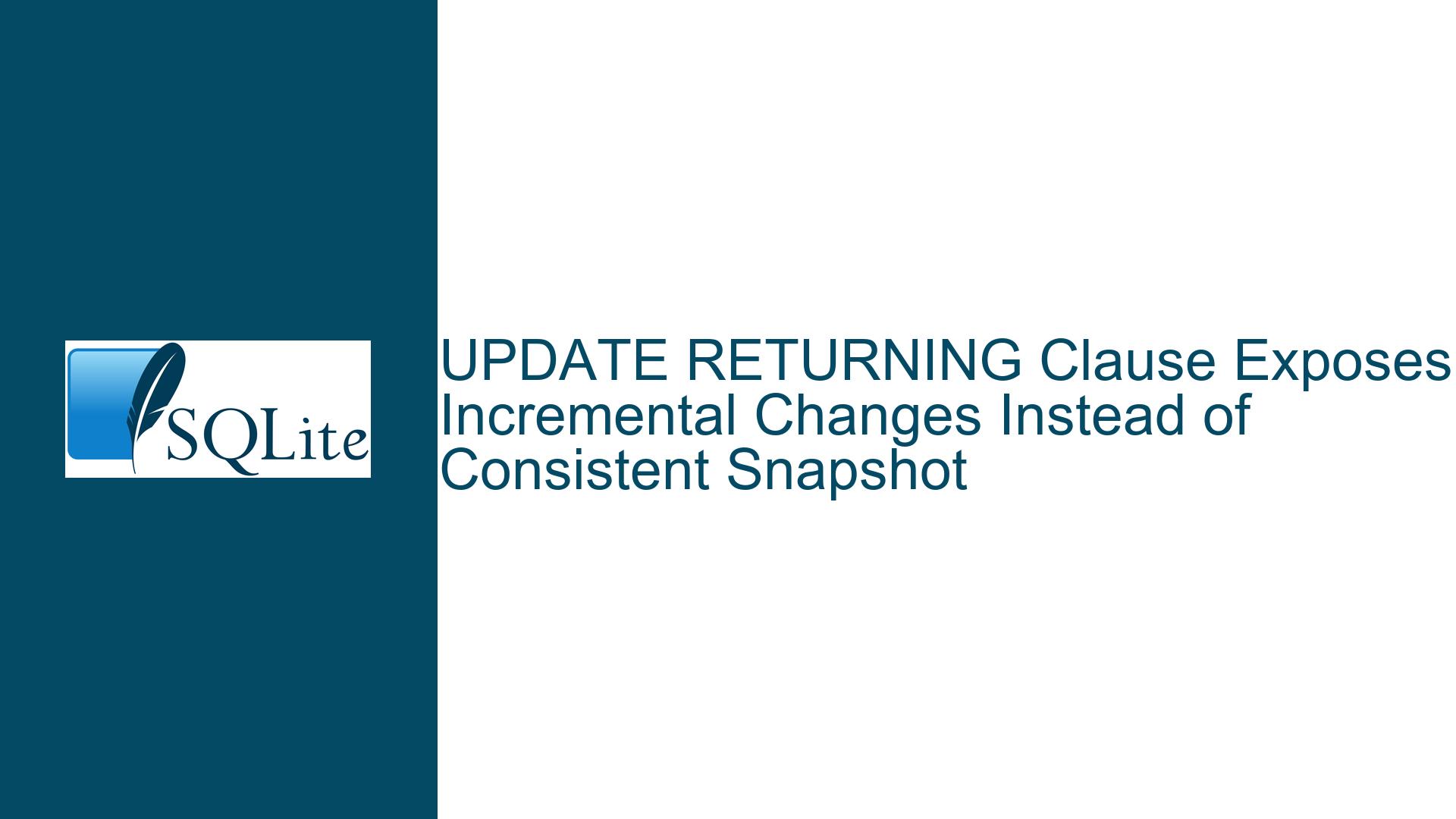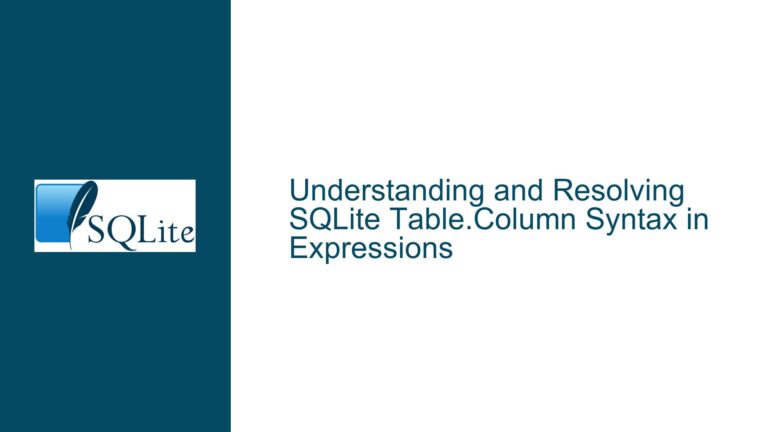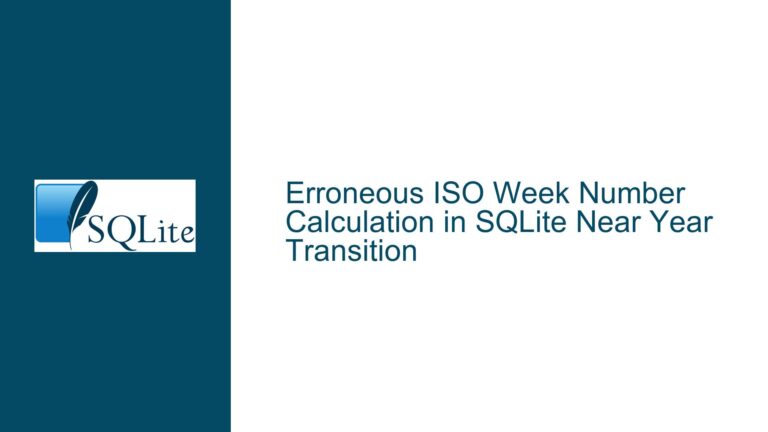UPDATE RETURNING Clause Exposes Incremental Changes Instead of Consistent Snapshot
Understanding the UPDATE RETURNING Clause’s Incremental Data Visibility
Issue Overview: RETURNING Clause Reflects Intermediate Row States During Bulk Updates
The core issue arises when using the UPDATE ... RETURNING syntax in SQLite to modify multiple rows and return computed results based on the updated state of the database. Users expect the RETURNING clause to evaluate expressions against a consistent snapshot of the database after all rows have been updated. However, SQLite computes the RETURNING output incrementally as each row is updated, leading to observable inconsistencies in the returned data.
In the example provided, an UPDATE statement moves all children from one parent to another and attempts to return a JSON structure that includes all children now belonging to the new parent. Instead of showing all five children under the new parent in every returned row, the output reveals a progressively growing list of children. This occurs because the RETURNING clause’s subquery (which aggregates children under the new parent) re-executes for each updated row, observing the partially updated table state. The first updated row sees only three children (the original two plus itself), the next row sees four, and the final row sees all five. This violates the expectation that all three returned rows should reflect the final state of the database after the entire UPDATE completes.
This behavior is not a bug but a deliberate design choice in SQLite’s implementation of the RETURNING clause. The database engine processes the UPDATE statement row-by-row, evaluating the RETURNING expressions immediately after each row modification. The results are stored in a temporary buffer and emitted to the client only after all updates are applied, but the expressions themselves are evaluated mid-operation. This creates a paradox: while the client receives all results atomically (no partial results if the statement is interrupted), the computed values reflect a shifting database state.
Possible Causes: Row-Level Evaluation and Subquery Re-Execution
The discrepancy stems from three interrelated factors:
Row-by-Row Execution of DML Statements:
SQLite processesUPDATEstatements by iterating over each qualifying row, applying changes, and evaluating theRETURNINGclause for that row before moving to the next. This is efficient for large datasets but means that any subqueries or expressions in theRETURNINGclause see the database in a transient state. For example, a subquery that aggregates child rows will include previously updated rows but not those yet to be processed.Lack of Isolation Within the Statement’s Execution Context:
Unlike transactional isolation levels (e.g.,SERIALIZABLE), which guarantee a consistent view across multiple statements, a singleUPDATE ... RETURNINGstatement does not isolate its subqueries from the changes it is making. The subqueries in theRETURNINGclause observe the cumulative effect of theUPDATEas it progresses, breaking the illusion of atomicity within the statement.Misuse of the RETURNING Clause for Post-Update Queries:
TheRETURNINGclause is designed to return data directly related to the rows being modified (e.g., new column values). When used to execute complex subqueries that reference other rows in the same table—especially those affected by the sameUPDATE—it inadvertently exposes the internal execution order of the statement. This is an anti-pattern, as the clause is not intended to serve as a post-update query mechanism.
Resolving Inconsistent RETURNING Outputs: Workarounds and Best Practices
To achieve a consistent view of the database state after an UPDATE, the following strategies can be employed:
Separate the Update and Query Operations:
Execute theUPDATEwithoutRETURNING, then run a separateSELECTquery to retrieve the desired data. This ensures theSELECTsees the final state of the database. For example:BEGIN TRANSACTION; UPDATE Child SET ParentId = 1 WHERE ParentId = 2; SELECT JSON_OBJECT(...) FROM Child WHERE ParentId = 1; COMMIT;This approach guarantees that the
SELECTquery operates on a stable dataset, as theUPDATEhas already completed.Use a Temporary Table to Capture Affected Rows:
If the updated rows need to be referenced in a subsequent query, useRETURNINGto store their identifiers in a temporary table, then join this table with the main data in a follow-upSELECT:CREATE TEMP TABLE UpdatedChildren (ChildId INT); UPDATE Child SET ParentId = 1 WHERE ParentId = 2 RETURNING ChildId INTO UpdatedChildren; SELECT JSON_OBJECT(...) FROM Child WHERE ChildId IN (SELECT ChildId FROM UpdatedChildren);This decouples the data modification from the data retrieval, avoiding mid-update visibility issues.
Leverage Common Table Expressions (CTEs) for Atomic Operations:
Combine theUPDATEandSELECTinto a single statement using a CTE. This ensures theSELECTruns in the same transaction and sees the updated data:WITH Updated AS ( UPDATE Child SET ParentId = 1 WHERE ParentId = 2 RETURNING ChildId ) SELECT JSON_OBJECT( 'ChildId', c.ChildId, 'Parent', (SELECT ... FROM Parent WHERE ParentId = 1) ) AS data FROM Child c JOIN Updated u ON c.ChildId = u.ChildId;Note that this still requires careful handling to avoid referencing the same table being updated in subqueries.
Avoid Correlated Subqueries in RETURNING Clauses:
Restrict theRETURNINGclause to simple expressions involving the updated row’s columns. For example, returnChildIdandParentIddirectly, then use these values in a separate query:UPDATE Child SET ParentId = 1 WHERE ParentId = 2 RETURNING ChildId, ParentId;Process the returned
ChildIdvalues in application code and issue a follow-upSELECTto gather additional data.Understand SQLite’s RETURNING Clause Semantics:
Recognize that SQLite’sRETURNINGclause evaluates expressions per row during the update process, not after all rows are updated. This differs from PostgreSQL’s implementation, whereRETURNINGsees the final state of the table. Adjust expectations and design queries accordingly.
By adhering to these practices, developers can avoid unexpected inconsistencies when using UPDATE ... RETURNING in SQLite. The key takeaway is to treat the RETURNING clause as a mechanism for returning row-specific data at the moment of modification, not as a tool for querying the database’s post-update state. For complex reporting needs, always follow bulk modifications with a dedicated SELECT statement.






